January 1, 2020

Sponsored Content
The number of resistant weeds has grown at an alarming rate over the last 30 years. Most of us remember weed management in two eras, prior to Roundup Ready® and Roundup Ready crops. In the early 1990’s before Roundup Ready crops, the number one post-emergence herbicide used in soybeans were ALS or Group 2 herbicides. We tend to forget about ALS resistant weeds because in 1996, soybean farmers had one of the most effective post-emergence options with glyphosate in Roundup Ready crops.
By 2001, the first case of glyphosate resistant (GR) marestail was reported. Farmers battling GR weeds spent many years spraying fields with PPO herbicides such as Cobra® but had marginal success because of PPO resistant populations. By 2010, many soybean fields had waterhemp, marestail, and giant ragweed that had escaped post-emergence applications. By the, simple weed management had ended for farmers battling resistant weeds. With the lack of effective post-emergence herbicide options, residuals became very important. In that time, farmers had to learn the various herbicide groups as well as the concept of never letting weeds emerge. Shortly after, LibertyLink® soybeans started to take off and were followed by Roundup Ready 2 Xtend® and Enlist E3® soybeans. Today, we once again have very effective herbicide options.
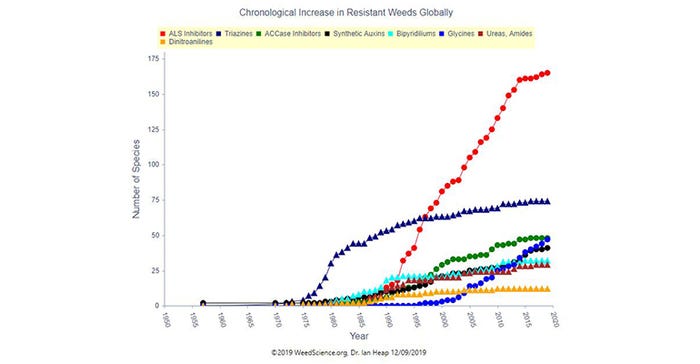
Weed Management is at a Cross Road
Over the past decade, we have gained a better understanding of the importance of the pre-emergence and in-season residuals that result from the use of multiple SOA’s. However, as we face lower commodity prices, many wonder if cutting pre-emergence applications could help save on costs since we once again have effective post-emergence herbicide options. But for a sound weed resistance strategy, we must utilize an effective pre-emergence option upfront, regardless of what trait platform is selected.
The best way to fight weeds is to never let them emerge. The pre-emergence application will reduce the number of weeds that germinate, thus reducing the number of weeds present at the time you apply your post-emergence herbicide This will ultimately reduce the selection pressure on the post-emergence herbicides. Every time a herbicide is applied, we are essentially selecting for resistant weeds. Therefore, utilizing multiple SOA’s will help reduce the number of escapes that could potentially be resistant, which showcases the importance of the Power in the PRE™, followed by an effective post-emergence herbicide application.
Power in the PRE™
The number of resistant species has significantly increased over the last ten years. What makes this even more alarming is the number of populations that have become resistant to more than one SOA. Over the past few years, two very alarming events have occurred in waterhemp management.
A six-way resistant waterhemp population was reported by Dr. Kevin Bradley at the University of Missouri. This is an extreme case as two and three-way resistant populations more common in many waterhemp populations.
Group 15 resistant waterhemp was reported by Dr. Aaron Hager at the University of Illinois. Group 15 herbicides play a key role in weed management, showcasing the complexity of 21st century weed management.
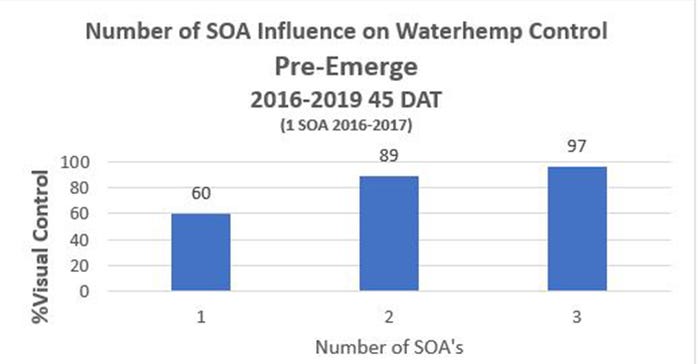
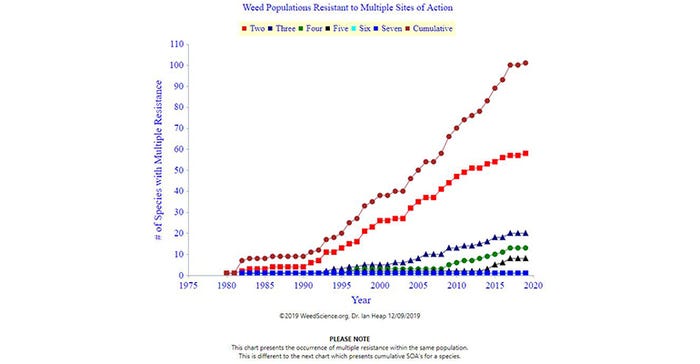
Understanding the resistant weeds you are up against is also critical to reduce the amount of pressure on one herbicide group. For instance, many waterhemp populations are resistant to Group 2 herbicides. Therefore, selecting a Group 2 and a Group 14 herbicide will provide SOAs, but if the population is resistant to Group 2 herbicides, there would only be one effective SOA for the ALS resistant waterhemp. According to Beck’s PFR data, products such as Zidua Pro®, Fierce® XLT and Trivence® that have three SOAs provide greater waterhemp control compared to products like Authority®Maxx and Prefix® that only have two SOAs.
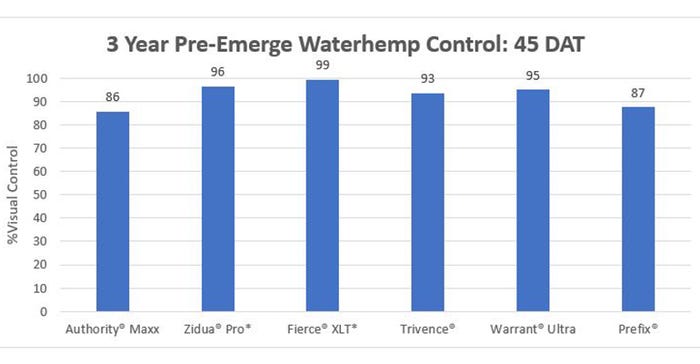
In-Season Residuals
The best way to fight weeds is with competition and canopy closure. However, a pre-emergence herbicide typically only last four to five weeks, depending on weather conditions. In-season residuals provide another layer of protection until canopy closure. Group 15 herbicides such as Dual II Magnum®, Outlook®, Warrant, and Zidua® will provide effective control of grasses and small seeded broadleaf weeds like waterhemp. These products will not provide post-emergence activity so applications should be made based on the calendar and not until after the weeds emerge. Proper application timing will also help ensure that weeds that escaped the pre-emerge will be smaller, allowing the tank mixed post-emergence herbicide to be effective. Across multiple platforms and multiple Group 15 herbicides, Beck’s Practical Farm Research (PFR)® data has shown a 6% increase in waterhemp control. And while that may not sound substantial, when one plant can produce hundreds of thousand seeds, an in-season residual is worth the investment.
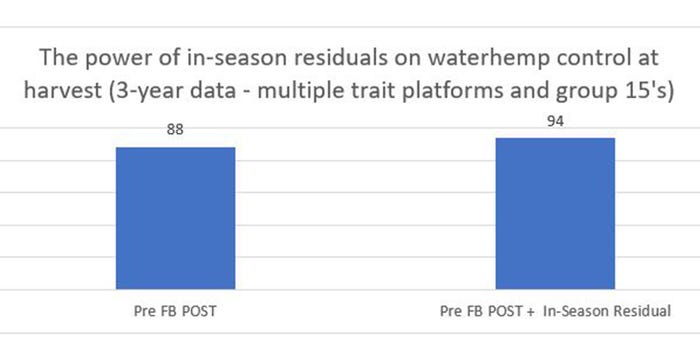
Reducing POST Selection Pressure
We know that canopy closure can play a significant role in the fight against resistant weeds thanks to the crop competition, but are there other methods that can help? One way to achieve canopy closure earlier is by planting in narrow rows as weeds are less competitive in narrower spacing. Early planting can also help canopy closure occur earlier in the season, making it much more difficult for weeds to emerge. This is very important for later emerging summer annuals.
Because of the biomass, cover crops can play a significant role in reducing weed pressure as it will make it much more difficult for weeds to emerge. Over the last few years, many Universities started conducting research on weed seed destroyers to see if by destroying the weed seed that comes out of the combine, we might reduce the number of weed seeds that are added to the soil seed bank.
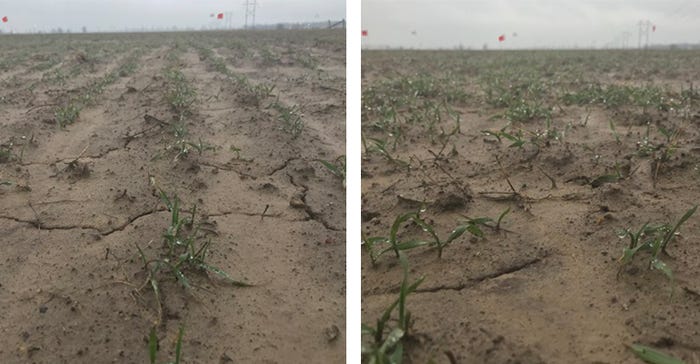
Weed management is always changing, but one common dominator is handling resistant weeds. While some of the ideas mentioned here like cover crop and the weed destroyer may not fit into your operation, the Power in the PRE-and layering residuals is something that should be considered in every operation.
Regardless of what soybean technology you are planting, when it comes to herbicide programs and weed control, there are four important things to remember:
Control weeds before they emerge
Use multiple effective sites of action
Spray by the calendar, not by how your fields look
Layer residuals
Contact your local Beck’s representative to learn how to successfully manage your Roundup Ready 2 Xtend soybean fields in 2020.
Beck’s is the largest family-owned retail seed company in the United States that serves farmers in Illinois, Indiana, Iowa, Kentucky, Michigan, Minnesota, Missouri, Ohio, South Dakota, Tennessee, and Wisconsin. According to a recent seed industry survey, Beck’s ranks as the fourth largest corn and soybean brand in the United States. At their core, all Beck’s employees are Farmers at Heart. It stands for something special. It has soul. It has truth. And it represents a community of farmers, employees, and dealers who strive each day to seek challenges, push boundaries and innovate. Beck’s has, and always will be, proud to serve a community of farmers who love what they do and who are proud to be… Farmers at Heart. For more agronomic new and information, visit Beck’s Agronomy Talk page or blog at BecksHybrids.com.
Roundup Ready 2 Xtend® and Warrant® are registered trademarks of Bayer Group. Cobra®, Fierce® XLT, is a registered trademark of Valent USA Corporation. LibertyLink® is a registered trademark of Bayer CropScience. Zidua®, Zidua Pro® and Outlook® are registered trademarks of BASF. Enlist E3® and Trivence® is a registered trademark of Corteva Agriscience. Authority® Maxx is a registered trademark of FMC Corporation. Prefix® and Dual II Magnum® are registered trademarks of a Syngenta Group Company.
About the Author(s)
You May Also Like




